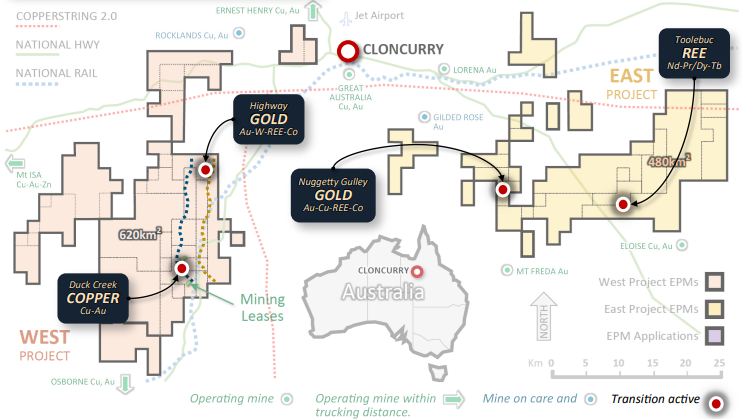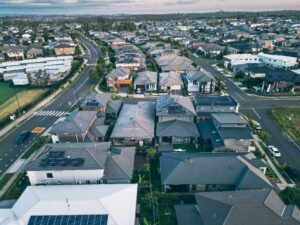New thinking helps 2025 ASX IPO candidate Transition Resources make new discoveries in Cloncurry

Humble beginnings
The resources industry in Australia attracts people with a diverse array of backgrounds, and David Wilson, Managing Director of Transition Resources, is no exception. With an early aptitude for oil painting and despite finding his first ounce of gold as a 12-year-old panning with a rubbish bin lid just 20 kilometres from the Melbourne CBD, his first career kicked off when he founded a niche architectural practice in the 1980s. At a time when high-level CAD stations were the size of small bedrooms, he was among the first in the country to offer computer aided design and virtual reality on a desk-top platform.
Gold digger
Fifteen years later this was no longer unique, so Wilson turned to full-time investing, and followed his childhood interest in gold prospecting, by investing in resource stocks. And then this Renaissance Man became… an exploration manager. You see, Wilson had invested in a company called CuDeco, ASX: CDU, whose company-making discovery in 2006 was the Rocklands copper–cobalt–gold deposit near Cloncurry in northwestern Queensland. After using his CAD skills to model the orebody from ASX releases, in 2008 Wilson contacted the Rocklands team with some ideas, and he was promptly invited to move to Cloncurry, to help find the deeper, elusive parts of the orebody.
Ten years a Cloncurry local
This kicked off ten years for Wilson as a Cloncurry local, and progressively more complex roles in a new industry, including Exploration Advisor, Exploration Manager, Pit Geology Manager and, eventually, Asset and Development Manager. During this time, Wilson lent his had to many areas of the project, planned over 250,000 metres of drilling, developed innovative 3D exploration and geophysics systems, and designed purpose-fit ore-management systems to deal with the unique Rocklands orebody.
To his regret, one area of the project Wilson was never involved in was the processing plant, and when the company reported it was not performing as expected, and public disagreements between major shareholders and the executive risked degrading the project, Wilson began to think about life after Rocklands, and where the next big discoveries might be lurking in this copper-rich part of Queensland.
Making the transition
Wilson says he left Rocklands in 2017 with a heavy heart but used the opportunity to ‘Transition’ to a new phase of his career, by assembling his own exploration ground. The result is Transition Resources, which has two project areas covering 1,100 sq km to the east and west of Cloncurry. The company is contemplating an ASX listing in early 2025.

Transition’s tenements (Source: Company pre-IPO information sheet)
A21 km long gold-rich mineral system
Wilson’s initial thinking was to focus on outliers – mineral systems that are not easily explained using accepted geological models. His first target was to acquire ground around the historical Success Mine which produced around 330 tonnes of very high-grade cobalt ore in the 1920s (up to 50% cobalt out of the ground). He also focussed on areas that included important iron-rich rock types in contact with quartzites, which he felt offered regionally important discovery opportunities. At the time, commodities like copper and gold were out of favour, and open ground was up for public application all over Cloncurry. Existing tenement holders were often happy to get ‘non-core’ tenements off their books.
Despite a rich history of greenfield discoveries in the Cloncurry district going back to the 19th Century, the geological focus in the region has become polarised in recent decades, so until Transition there had been no greenfield discoveries in a long time. Wilson believed that new thinking could potentially identify new deposits, and he didn’t have to wait long. In Transition’s first area of focus, after just five months of field work, the new thinking led to a groundbreaking new discovery in 2019 called ‘Highway’.
Highway to riches
Highway occurs in a location where there are no historical workings or records of modern exploration. The suite of contained metals, such as gold, tungsten, rare earths and cobalt, make it a first for the region. The lack of copper in the system, which is equally unique, might explain why prior explorers in the area, for more than 120 years, had failed to recognise its potential.
Transition estimates that over 100,000 ounces of gold will be defined first-up at Highway, at grades above 3 g/t gold, plus critical metals byproducts, and an independent JORC2012 resource is pending. But this is just the start of what could be a much larger deposit, because mineralisation is open along strike and below the deepest drill holes at just 200 metres, and the pending resource will be defined from just 870 metres of strike, within a 21 km long gold-rich mineral system. This system has not been drilled previously and Highway remains open in all directions.
Success at Success
The starting point for Highway centred on Wilson’s interest in the earlier mentioned Success cobalt mine from 1927. There’s not much high-grade cobalt in the Mt Isa Inlier so its presence here, 25 km southwest of Cloncurry, is intriguing. As the first project of focus for his new company, and perhaps a clue to Wilson’s approach to business, he felt it was important to track down descendants of the original mine owner – the great granddaughter was found and became guest of honour at a specially arranged site visit.
The first field trials of Transition’s new exploration methods targeted areas with no historical workings north of the old cobalt mine, and field reconnaissance identified several lightly mineralised, but generally underwhelming structures, which were sampled over a decent strike length. Transition noticed a subtle shift in rock-chip geochemistry from copper-gold relationships to cobalt-gold relationships as they moved east. This prompted some excitement when Wilson noticed the zone was trending directly towards another of his high-priority remote targets.
Field reconnaissance jumped forward to this remote target and identified a modest outcrop of quartz-rich breccia, where pXRF analysis indicated very high tungsten (W), gold (Au) and Yttrium (Y) readings. The prospect was named ‘Highway’ after these high W, Au, and Y readings. Large geochemistry and geophysics programmes followed, and in late 2020 drilling confirmed Highway was indeed a decent greenfield discovery.
Enter the Professor
During this developing first significant discovery, Wilson tracked down Professor Kenneth Collerson, a geochemist and Emeritus Professor of Earth Sciences at the University of Queensland, and an authority on the rare earth elements (REEs). Professor Collerson had recently tabled several studies for the region, which Wilson felt were a good fit for the unusual geochemistry he was seeing. Professor Collerson was commissioned to undertake a Mineral System Characterisation and Prospectivity Review of Transition’s tenements.
In a stroke of good timing, the Highway outcrop was discovered whilst Professor Collerson was preparing his report, and because its unique geochemistry is a perfect fit to his alternative focus, it was not long before he joined Transition as Director of R&D. Transition has since invested over $14m into its R&D programmes, supercharging Professor Collerson’s ability to build on his previous work, by generating significant scientific evidence for his theories, and providing context through the development of what Transition is calling The Model – a cohesive new mineral system model for the region.
Other findings
Professor Collerson is anticipated to publish a scientific Paper on his findings in 2025 and, in the meantime, can reveal elements of is alternative findings, such as,
“Metals in the North West Minerals Province of Queensland are derived from mantle plume-associated alkaline (and tholeiitic) mafic and ultramafic magmas. The Model also incorporates the role of slab-tears that provide a window for plume melts to enter the mantle wedge. Thermochemical mantle plumes exert upward pressure on shallow crustal settings and can form low-strain environments conducive to metal deposition.
The Model addresses deficiencies in existing theory, where metals are interpreted to be sourced from basin sediments by circulating brines or introduced in magmatic hydrothermal fluids emanating from Williams-Naraku Batholith granitoids.
Scientific assessment by Transition of thousands of samples consistently shows geochemical profiles similar to porphyry systems, not granite-derived systems. This is further supported by the discovery of a previously unknown, fossil hot-spring epithermal system at the greenfield Highway (Au-W-REE-Co) discovery. This is likely to have formed above a deeper porphyry igneous source. It is possible Transition’s Duck Creek Anticline tenements may represent Australia’s largest, unrecognised porphyry system.
Alternative exploration methodologies include geochemical vectoring using uncommon metal suites and improved structural comprehension, which guides enhanced interpretation of geophysics.”
Two out of two for Transition
For its second major programme, and guided by The Model as it develops, Transition targeted its regionally well-recognised brownfield Duck Creek copper system, which parallels the gold system for a similar strike length. Drilling was immediately successful, and after just four months of active drilling from October 2022, Transition was able to report a JORC2012 resource of 5.44 million tonnes at 1.45% Cu. As with Highway, Duck Creek (shown below) remains open in all directions. That makes two out of two for Transition.
Whilst these two discoveries grow, Transition’s next line of discoveries may well include high-grade REEs which it has identified in drilling adjacent to a large, 5 km wide circular geophysical anomaly east of Cloncurry, and at a developing new REE prospect west of Cloncurry, where high-grade REEs have so far been identified over 800 metres of strike. Both projects include magnet REEs with results including light rare earths neodymium/praseodymium oxide (up to 4,318 ppm) and heavy rare earths dysprosium/terbium oxide (up to 351 ppm).

Source: Company pre-IPO information sheet
Two shallow, high-grade, and low-capex projects
The Model is presenting Transition with first-mover advantage in one of the most significant mineral provinces on the planet. But discoveries cost money, so Transition intends to pursue near-term revenue, to self-fund its activities, by developing parts of its still growing Highway and Duck Creek resources. This is possible because both deposits are shallow, high-grade, and offer low-capex, open-pit, fast-tracked revenue opportunities, including toll treating copper-sulphide ore at local mills, and low-cost gravity separation of gold-rich ore at Highway. Both mines are immediately adjacent to rail and road.
Keep your eye on Transition Resources
Transition bears watching because it comes with two discoveries, funded without the company having to go public, and the company’s sights are firmly set on early revenue, earnings per share (yes, really), growth in existing resources, and new discoveries. It is also noteworthy that in its show of respect for shareholders, many of whom have followed Wilson from the Rocklands project, Transition operates like an ASX listed company, as evidenced by no less than 90 shareholder updates in six years.
With first production possible from Duck Creek in 2026, Transition’s payday could be coming relatively quickly. And, since David Wilson is in charge, we expect the company will be uniquely focused on good outcomes for its shareholders. Investors who like copper or gold, should stay tuned.
What are the Best ASX Stocks to invest in right now?
Check our buy/sell tips

Blog Categories
Get Our Top 5 ASX Stocks for FY26
Recent Posts
Diversifying Portfolios with ASX Consumer Stocks: Opportunities and Risks
The ASX 200 has delivered significant volatility recently, and market participants observing the screens in 2025 understand the turbulence firsthand.…
Is Lendlease (ASX:LLC) out of the doldrums for good?
Lendlease (ASX:LLC) has for the past several years been the classic definition of a ‘value trap’. You think a good…
Here are the 2 most important stock market taxes that investors need to be aware on
As one of two certainties in life, investors need to be aware of stock market taxes. Investors may be liable…


